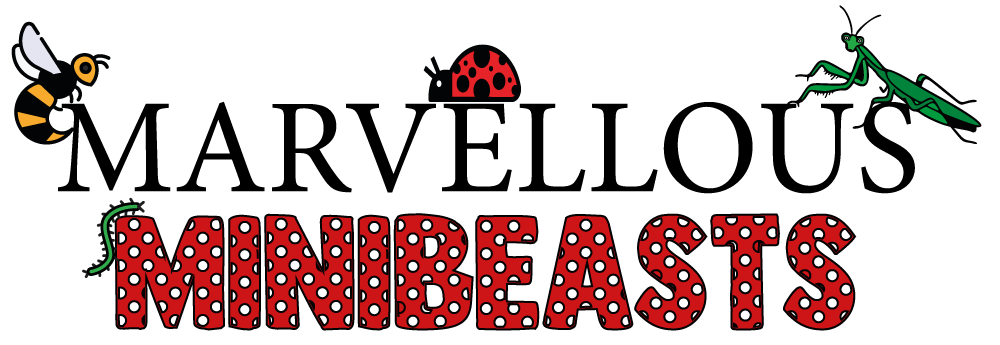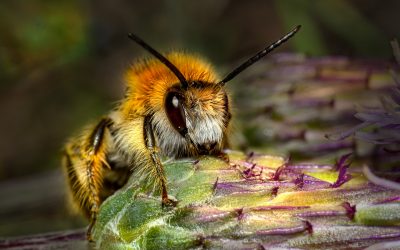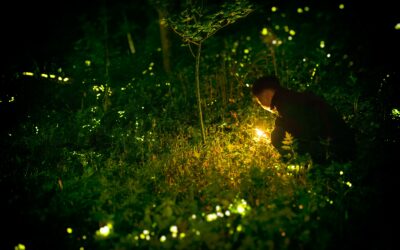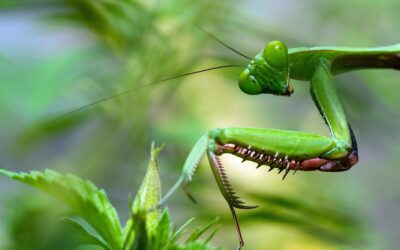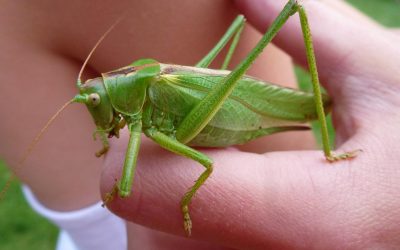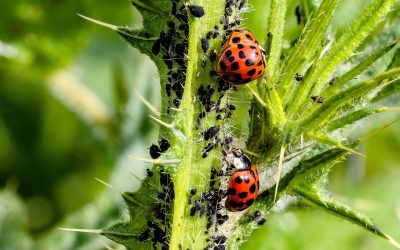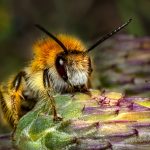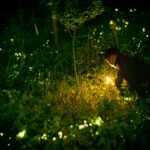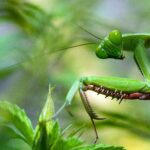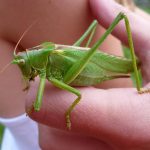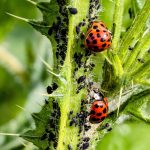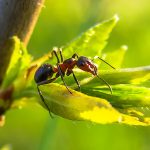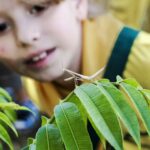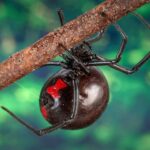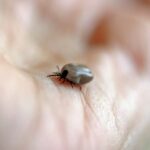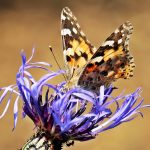Insects are fascinating creatures that play a vital role in the ecosystem. While some insects may seem scary to most people, it’s important to remember that most are harmless and play a significant role in maintaining a healthy garden. However, some insects can be dangerous and may require extra caution when encountered. In this blog post, we will explore the scariest insects found in the garden and provide information on how to identify and avoid them.
What is an insect?

Insects are part of the arthropod family, which includes spiders, scorpions, and crustaceans. They are small invertebrates with three body segments and six legs. Insects are the most diverse group of animals on Earth, with over a million species identified to date. Some of the most commonly found insects in gardens include bees, butterflies, ants, ladybirds, and grasshoppers. They play an essential role in the garden ecosystem by pollinating plants and serving as a food source for birds and other wildlife.
What is an insect? click here to find out more.
Scary insects found in gardens
While most garden insects are harmless or even beneficial, some can be considered scary due to their appearance or behaviour. These insects may have stingers, sharp mandibles, or a frightening size. Some common scary insects found in gardens include wasps, hornets, and praying mantises. These insects can be intimidating, but they typically only sting or bite when provoked, and they serve important roles in the garden ecosystem.

Top Five scariest insects found in the garden

While gardens are home to many beneficial insects, there are also some that can be scary to encounter. In this section, we will explore the top five scariest insects found in gardens, including their physical characteristics, habitats, diets, and how to identify them.
- Giant Water Bug – Also known as the toe-biter, this insect is often found in bodies of water. They are large and have a powerful bite that can be quite painful. They are known to prey on small fish and frogs.
- Asian Giant Hornet – This invasive species has made headlines for its aggressive behaviour and painful sting. They are known to attack in groups and can be deadly to humans, especially if stung multiple times.
- Tarantula Hawk Wasp – These wasps are named for their habit of hunting tarantulas. They have a very painful sting that can last up to five minutes. However, they are not typically aggressive towards humans.
- Jerusalem Cricket – Also known as a potato bug, these insects have a distinctive appearance with a large, round head and strong jaws. While they are not dangerous, their appearance can be quite intimidating.
- Praying Mantis – While praying mantises are beneficial insects that help control pest populations, their appearance can be quite scary. They are known for their distinctive shape and fierce hunting abilities.
Giant water bug

Giant water bug credit: Frank Vassen
The giant water bug, also known as the toe-biter, is a large and scary insect that can be found in gardens, particularly those with ponds or streams. This predatory insect is known for its powerful bite, which can be quite painful to humans. Here are some key details about the giant water bug:
Description
Giant water bugs are aquatic insects that can grow up to four inches in length. They have a flat, oval-shaped body with a pointed head and long, flat legs that are adapted for swimming. Their bodies are usually brown or green with a mottled pattern.
Physical appearance
As mentioned, giant water bugs have a flat, oval-shaped body with a pointed head and long, flat legs. Their bodies are usually brown or green with a mottled pattern. They have a large, powerful bite that is used to capture prey and defend themselves.
Habitat
Giant water bugs are found in freshwater bodies such as ponds, streams, and rivers. They can also be found in garden fountains or other water features.
Diet
Giant water bugs are predators that feed on small fish, insects, and other aquatic animals. They use their powerful bite to capture prey and inject digestive enzymes that help them break down the prey’s tissues.
How to identify a giant water bug
Giant water bugs are usually found in or near bodies of water. They are large and have a distinctive shape with long, flat legs. They may also be identified by their large, powerful bite and aggressive behaviour.
Precautionary measures
To avoid getting bitten by a giant water bug, it’s best to avoid handling them. If you must handle one, use a container or scoop to gently lift it out of the water. If you are bitten, seek medical attention if the pain or swelling becomes severe.
Tarantula hawk wasp

Tarantula hawk wasp and tarantula credit: David Crummey
The tarantula hawk wasp is a frightening insect that can be found in gardens in the western United States and Mexico. Here are some details about its physical appearance, habitat, diet, how to identify it, and precautionary measures to take if you encounter one.
Physical appearance
The Tarantula Hawk Wasp has a metallic blue-black body and bright orange wings. It can grow up to 2 inches in length and has a very painful sting that can last up to 5 minutes.
Habitat
These wasps prefer dry, open habitats such as deserts and grasslands.
Diet
Tarantula hawk wasps are predators that feed on tarantulas. The female wasp stings the tarantula and lays her eggs on it. The larvae then feed on the paralysed spider.
How to identify a tarantula hawk wasp
Tarantula hawk wasps are quite large and have a distinctive metallic blue-black body with bright orange wings. They are often seen flying close to the ground in search of tarantulas.
Precautionary measures
If you see a tarantula hawk wasp, it is best to keep your distance. Their sting is one of the most painful insect stings in the world. If you are stung, seek medical attention immediately. It is also recommended to wear protective clothing if you are working in areas where these wasps are known to inhabit.
Asian giant hornet

Asian giant hornet credit: Yasunori Koide
The Asian giant hornet is one of the top five scariest insects found in gardens. Here we discuss its physical appearance, habitat, diet, how to identify, and precautionary measures to take if you encounter one.
Physical appearance
Asian giant hornets can grow up to two inches long and have a distinctive orange and black pattern on their bodies. They have a large stinger that can be deadly to humans, especially if stung multiple times.
Habitat
Asian giant hornets are typically found in wooded areas, but they can also be found near buildings and homes.
Diet
They are predators that feed on other insects, including honeybees. They can destroy entire beehives in a matter of hours.
How to identify Asian giant hornets
Asian giant hornets are large and have a distinctive orange and black pattern on their bodies.
Precautionary measures
If you encounter an Asian giant hornet, it’s important to stay calm and move away slowly. Do not swat at the insect or make sudden movements, as this can provoke it. If you are stung, seek medical attention immediately, especially if you experience symptoms such as difficulty breathing or swelling of the throat. It’s also a good idea to contact a pest control professional if you suspect that Asian giant hornets are present in your garden.
Jerusalem cricket

Jerusalem cricket credit: Jon Cox
The Jerusalem cricket, also known as a potato bug, is a large insect that is found in western North America. It has a stout body and can range in size from one to two inches in length. Here are some details on its physical appearance, habitat, diet, how to identify it, and precautionary measures to take if you encounter one.
Physical appearance
They have a large, round head and strong jaws. Their bodies are usually brown or orange with stripes.
Habitat
They are typically found in areas with moist soil, such as gardens and forests.
Diet
They feed on small insects, roots, and tubers.
How to identify
Jerusalem crickets are large and have a distinctive round head.
Precautionary measures
Jerusalem crickets are not venomous and are generally not aggressive towards humans. However, they can bite if they feel threatened, so it is best to avoid handling them. If you encounter a Jerusalem cricket, simply leave it alone and allow it to continue on its way.
praying mantis

The praying mantis is a common insect that can be found in gardens. Here is some information on its physical appearance, habitat, diet, how to identify, and precautionary measures.
Physical appearance
The praying mantis has a long, slender body and distinctive “praying” forelegs that they use to capture prey. They come in a variety of colours, including green, brown, and pink. They have large eyes and a triangular-shaped head.
Habitat
Praying mantises are found throughout North America and can be found in a variety of habitats, including gardens, fields, and forests.
Diet
They are carnivores and feed on other insects, including butterflies, moths, and grasshoppers. They are also known to eat small lizards and even hummingbirds.
How to identify a praying mantis
Praying mantises are easily identifiable by their long, slender bodies and “praying” forelegs. They can range in colour from green to brown to pink.
Precautionary measures
Praying mantises are generally not harmful to humans, but they can bite if provoked. It is important to avoid handling them and to keep them away from pets that may try to play with or eat them.
Our pick for the scariest insect
We think the scariest insect found in gardens is the tarantula hawk wasp. Despite its name, this insect is not a hawk or a tarantula, but a species of solitary wasp. Tarantula hawk wasps are found throughout the United States and can grow up to two inches long. They have shiny blue-black bodies and wings, with bright orange-red legs.
We think the tarantula hawk wasp wins the top spot as the scariest insect due to its large size, powerful sting, and predatory behaviour. Did you know the female tarantula hawk wasp hunts tarantulas to use as hosts for their larvae? The wasp will paralyse the tarantula with its sting and drag it back to its nest, where it will lay its eggs on the still-living tarantula. When the eggs hatch, the wasp larvae feed on the tarantula’s body.

Tarantula hawk wasp credit: Charles J. Sharp
Interesting facts about tarantula hawk wasps
Despite their scary reputation, tarantula hawk wasps play an important role in the garden ecosystem. They are pollinators and feed on nectar and pollen from flowers. The female wasp’s hunting behaviour also helps regulate the population of tarantulas, which can have a negative impact on other species if left unchecked.
Tarantula hawk wasps also have some interesting physical characteristics. Male tarantula hawk wasps do not have stingers and feed on flower nectar, while females have stingers and are larger in size. Additionally, tarantula hawk wasps have been observed using their wings to create vibrations on the ground, which can be used to locate prey.

Tarantula hawk wasp credit: Marc Kummel
Dangers posed by tarantula hawk wasps
Tarantula hawk wasps are not aggressive towards humans and typically only sting when provoked. However, their sting is considered one of the most painful in the insect kingdom. The venom of the tarantula hawk wasp attacks the nervous system, causing intense pain that can last for several minutes. While the sting is not life-threatening, it can cause an allergic reaction in some people. If a tarantula hawk wasp feels threatened, it may sting in self-defence.
Final thoughts on the tarantula hawk wasp
While the tarantula hawk wasp may be considered scary, it is an important part of the garden ecosystem. As with all insects, it is important to respect their role in nature and take steps to avoid unintentional harm. By learning about the scariest insect in the garden, we can gain
Importance of Children Learning About Insects
Insects may sometimes evoke fear in children due to their size, appearance, behaviour, or reputation for stinging or biting. However, it’s important to note that while insects have defensive capabilities, the majority of them are not harmful to humans.
Insects play a crucial role in maintaining a healthy ecosystem, beyond just their importance in pollination, decomposition, and pest control. They also contribute to the food chain, serve as indicators of environmental health, and provide vital ecosystem services such as soil aeration and nutrient cycling. By helping children understand this, they can learn to appreciate and respect insects for their ecological significance, and overcome any fear or apprehension they may have towards them.
Exploring and learning about insects in the garden can have a multitude of benefits for children. It can help them develop an appreciation for these tiny creatures and the important role they play in our world. In addition, learning about insects can also help children develop important scientific skills, such as observation, classification, and critical thinking.
However, it is crucial to ensure that children explore insects safely and responsibly. Insects can be frightening to some children, especially those who have had negative experiences with them in the past. It’s important to teach children that insects, if treated with respect, are perfectly safe to observe and handle.
It is also essential to ensure that children do not harm insects or their habitats. Children should be taught to observe insects from a safe distance, and to avoid touching them unless they are under adult supervision.

Exploring Insects Safely in the Garden
Exploring insects in the garden can be an exciting and educational experience for young children. However, it’s important to take the necessary precautions to ensure that children can explore and learn about insects safely. Here are some helpful tips to help young children safely explore the fascinating world of insects in the garden.
Use child-friendly insect guides
Child-friendly insect guides can be valuable resources to help young children identify and learn about insects in the garden. Look for books or online resources that are specifically designed for children, with colourful illustrations and simple language that is easy for them to understand.
Use these guides to help your child identify different insects they encounter in the garden and learn interesting facts about their characteristics, behaviours, and habitats. This can be a fun and educational way for children to expand their knowledge about the insect world and develop a deeper appreciation for these tiny creatures.
Teach safety rules
Teaching safety rules to young children is crucial when it comes to exploring insects in the garden. Make sure your child understands the importance of handling insects safely. For example, they should never touch an insect without permission from an adult and should never put an insect in their mouth.
Instruct them to observe insects from a safe distance and avoid handling them unless under adult supervision. This will help prevent any potential harm from insect bites or stings and ensure that your child interacts with insects in a responsible and safe manner.
Wear appropriate clothing
Wearing appropriate clothing is essential to protect young children from insect bites and stings while exploring insects in the garden. Encourage your child to wear long sleeves and trousers to cover their skin, reducing the risk of insect bites.
Closed-toe shoes should also be worn to protect their feet from any potential hazards. Additionally, consider applying insect repellent to exposed skin, following the manufacturer’s instructions, and considering the child’s age and health conditions. Proper clothing can serve as a barrier against potential insect bites or stings, ensuring a safe and enjoyable experience while exploring the fascinating world of insects.
Use tools
Using tools, such as bug catchers or nets, can be a safe and effective way for young children to catch and observe insects in the garden. Provide your child with child-friendly tools that are suitable for their age and size. Teach them how to use the tools safely and responsibly, such as not using excessive force or causing harm to the insects.
Encourage them to catch and release insects without causing any harm, and while respecting their natural habitat. Using tools can not only make insect exploration safer for children but also allow them to observe insects up close without direct contact.
Want to find insects? See our minibeast hunt guide here.
Choose the right time
Choosing the right time for insect exploration is important for the safety and comfort of young children. Insects are usually less active during the cooler parts of the day, such as early morning or late afternoon. Plan your insect exploration activities during these times to minimise the risk of insect bites or stings.
Avoid exploring during the hottest parts of the day, when insects tend to be more active and aggressive. Additionally, be mindful of weather conditions such as heavy rain or extreme heat, as these may affect the presence and behaviour of insects in the garden. Planning your insect exploration for the right time of day can help ensure a safer and more enjoyable experience for young children.
Supervise your child
Supervision is crucial when young children are exploring insects in the garden. Always keep a close eye on your child to ensure their safety. Insects can move quickly and may be difficult for children to handle safely on their own.
Supervising your child allows you to guide and instruct them on safe handling practises, remind them of the safety rules, and intervene if any potential hazards arise. Additionally, supervising your child provides an opportunity for quality bonding time and shared learning experiences. So, remember to always be present and attentive when your child is exploring insects in the garden to ensure their safety and make it an enjoyable learning adventure.
Respect the insects
Respecting insects and their habitats is an essential lesson to instil in young children. Teach them to observe insects from a distance and avoid disturbing nests, hives, or harming insects in any way. Emphasise the importance of insects in the ecosystem and how they contribute to the balance of nature.
Encourage your child to appreciate the beauty and diversity of insects without causing harm to them or their habitats. This teaches children empathy, compassion, and respect for all living creatures, and fosters a positive attitude towards nature and the environment. By respecting insects and their habitats, children can develop a lifelong appreciation for the delicate balance of nature and the role of insects in it.

Final thoughts
Exploring and learning about insects in the garden can be a valuable and enjoyable experience for young children. By using child-friendly insect guides, teaching safety rules, wearing appropriate clothing, using tools, choosing the right time, supervising, and respecting insects, children can safely discover the fascinating world of insects.
It is important to remember that even the scariest insects like the giant water bug, Asian giant hornet, tarantula hawk wasp, Jerusalem cricket, and praying mantis can be observed and appreciated safely if treated with respect. By teaching children about the role of insects in the ecosystem and how to interact with them responsibly, we can help them develop a lifelong appreciation for these important creatures.
You Might Also Like
The Top 10 Most Common Insects in North America
Discover the top 10 most common insects in North America, their characteristics, behaviour, and the threats facing insect populations today.
Importance Of Bioluminescence In Nocturnal Insects
Explore the fascinating phenomenon of bioluminescence in nocturnal insects and how they use it for communication and defence.
The Benefits of Praying Mantises in the Garden
This article explores the fascinating world of praying mantises, their predatory behaviour, diet, and benefits of having them in your garden.
Nocturnal Insects You Can Spot In Your Garden
Explore the fascinating world of nocturnal insects in your own back garden! Learn about moths, beetles, crickets, and more.
The Role of Insects in Agriculture: How They Help and Hurt Crops
This article explores the role of insects in agriculture, discussing both their helpful and harmful impacts on crops.
